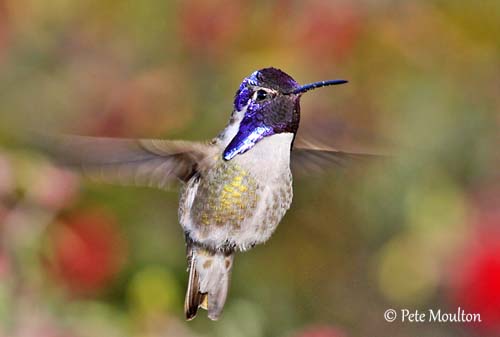
Fr: Colibri de Costa
All : Veilchenkopfelfe
Esp : Colibrí de Costa
Ital : Colibri di Costa
Nd : Costa – kolibrie
Sd : Costas Kolibri
Photographers :
Tom Grey
Tom Grey's Bird Pictures
Pete Moulton
Pete Moulton Photography
Text by Nicole Bouglouan
Sources :
HANDBOOK OF THE BIRDS OF THE WORLD Vol 5 by Josep del Hoyo-Andrew Elliott-Jordi Sargatal - Lynx Edicions - ISBN: 8487334253
A GUIDE TO THE BIRDS OF MEXICO AND NORTHERN CENTRAL AMERICA by Steve N. G. Howell, Sophie Webb - Oxford University Press - ISBN: 0198540124
BIRDS OF THE GREAT BASIN – by Fred A. Ryser - Univ of Nevada Pr -ISBN: 0874170796
FIELD GUIDE TO THE BIRDS OF NORTH AMERICA - National Geographic Society - ISBN: 0792274512
BirdLife International (BirdLife International)
All About Birds (Cornell Lab of Ornithology)
What Bird-The ultimate Bird Guide (Mitchell Waite)
Wikipedia, the free encyclopaedia
Costa’s Hummingbird
Calypte costae
Apodiforme Order – Trochilidae Family
BIOMETRICS:
Length: 9 cm
Wingspan: 11 cm
Weight: M: 3g – F: 3,20 g
DESCRIPTION:
The Costa’s Hummingbird male has iridescent deep violet crown and gorget, extending far down sides of neck, around the outside of the chest. It has light green back and short dark tail. Underparts are whitish, with green flanks. It has long dark wings.
The female has grey underparts, with sometimes a purple spot in the middle of the throat. She has green crown and white throat. She is slightly larger than male.
The bill is black and needle-shaped. The eyes are dark brown to black. Legs and feet are black.
The juvenile resembles female and reaches its adult plumage at one year.


VOICE: SOUNDS BY XENO-CANTO
The Costa’s Hummingbird utters a high, metallic “tink”, given in series. The male’s call is a loud “zing”, given from perches and during displays.
HABITAT:
The Costa’s Hummingbird is common in desert areas and dry chaparral. During migrations, they can be found in adjacent mountains and open meadows, sometimes gardens and woodlands.
RANGE:
The Costa’s Hummingbird breeds in Southern California and Arizona, Baja California and Western Mexico.
It winters in most parts of its breeding range. Its movements vary according to food resources.

BEHAVIOUR:
The Costa’s Hummingbird, as other Hummingbirds, can enter in torpid state to reduce its body temperature during the night. Its heart beats about 50 times per minute in torpid state. Usually, it beats about 500 to 900 times per minute. This state allows it to support low ambient temperatures.
This species is active and solitary. It migrates according to nectar resources and temperatures.
The Costa’s Hummingbird is an omnivorous bird, feeding mainly on nectar flowers, but also on tiny insects, caught by fly catching, or gleaning from vegetation.


The Costa’s Hummingbird’s courtship display includes aerial displays, such as broad loops accompanied by whistles when male dives from the top of the loop. The female may look at this display, responding with a burst of twitters. The male uses a good angle to the sun while is diving, to show off its violet plumage to impress mates.

The Costa’s Hummingbird may be aggressive against predators, performing a rapid dive bomb at the intruder and some flight displays.
FLIGHT:
The Costa’s Hummingbird performs hovering and flycatching when feeding.

REPRODUCTION:
The Costa’s Hummingbird is a solitary nester.
The nest is a beautiful woven cup decorated with leaves and lichens on the outside, and built under a protective branch of bush or small tree. Nest materials include plant down, bud scales, flowers and bark strips, bound with spider silk. The female builds the nest at about 1 to 2 metres above the ground.
She lays 2 white eggs, the second two days after the first. Incubation lasts about 15 to 18 days, by female alone. Chicks hatch altricial. They are fed by regurgitation, always by female. They fledge at about 20 to 23 days after hatching, and they are fed until they are independent and able to feed themselves.
The young reach their sexual maturity within the first year.
This species produces only one brood per year.

DIET:
The Costa’s Hummingbird feeds mainly on flower nectar, but also on small insects and pollen. It will consume about two thirds of its weight in a single day.
PROTECTION / THREATS / STATUS:
The Costa’s Hummingbirds’ populations are threatened by habitat loss in California, with human development in their coastal habitat.
In Sonora Desert, scrub areas are being cleared for agriculture and flood control along rivers.
Costa’s Hummingbirds hybridize with other species of Hummingbirds, diluting the gene pool of each species.
